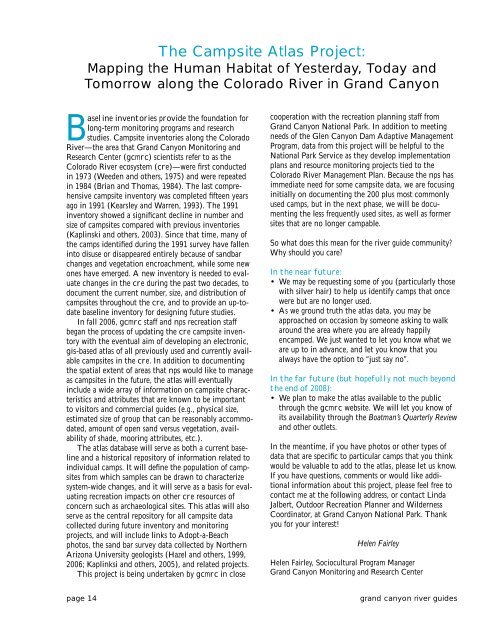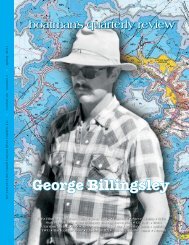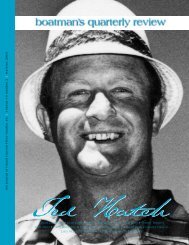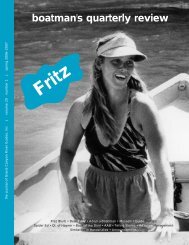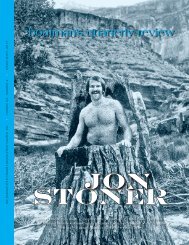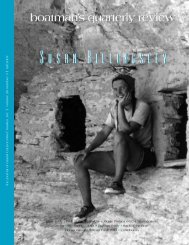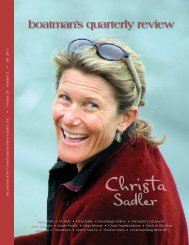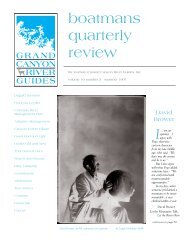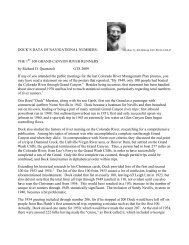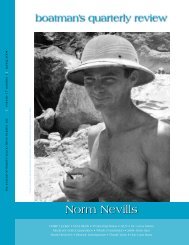summer 07 / 20:2 - Grand Canyon River Guides
summer 07 / 20:2 - Grand Canyon River Guides
summer 07 / 20:2 - Grand Canyon River Guides
Create successful ePaper yourself
Turn your PDF publications into a flip-book with our unique Google optimized e-Paper software.
The Campsite Atlas Project:<br />
Mapping the Human Habitat of Yesterday, Today and<br />
Tomorrow along the Colorado <strong>River</strong> in <strong>Grand</strong> <strong>Canyon</strong><br />
Baseline inventories provide the foundation for<br />
long-term monitoring programs and research<br />
studies. Campsite inventories along the Colorado<br />
<strong>River</strong>—the area that <strong>Grand</strong> <strong>Canyon</strong> Monitoring and<br />
Research Center (gcmrc) scientists refer to as the<br />
Colorado <strong>River</strong> ecosystem (cre)—were first conducted<br />
in 1973 (Weeden and others, 1975) and were repeated<br />
in 1984 (Brian and Thomas, 1984). The last comprehensive<br />
campsite inventory was completed fifteen years<br />
ago in 1991 (Kearsley and Warren, 1993). The 1991<br />
inventory showed a significant decline in number and<br />
size of campsites compared with previous inventories<br />
(Kaplinski and others, <strong>20</strong>03). Since that time, many of<br />
the camps identified during the 1991 survey have fallen<br />
into disuse or disappeared entirely because of sandbar<br />
changes and vegetation encroachment, while some new<br />
ones have emerged. A new inventory is needed to evaluate<br />
changes in the cre during the past two decades, to<br />
document the current number, size, and distribution of<br />
campsites throughout the cre, and to provide an up-todate<br />
baseline inventory for designing future studies.<br />
In fall <strong>20</strong>06, gcmrc staff and nps recreation staff<br />
began the process of updating the cre campsite inventory<br />
with the eventual aim of developing an electronic,<br />
gis-based atlas of all previously used and currently available<br />
campsites in the cre. In addition to documenting<br />
the spatial extent of areas that nps would like to manage<br />
as campsites in the future, the atlas will eventually<br />
include a wide array of information on campsite characteristics<br />
and attributes that are known to be important<br />
to visitors and commercial guides (e.g., physical size,<br />
estimated size of group that can be reasonably accommodated,<br />
amount of open sand versus vegetation, availability<br />
of shade, mooring attributes, etc.).<br />
The atlas database will serve as both a current baseline<br />
and a historical repository of information related to<br />
individual camps. It will define the population of campsites<br />
from which samples can be drawn to characterize<br />
system-wide changes, and it will serve as a basis for evaluating<br />
recreation impacts on other cre resources of<br />
concern such as archaeological sites. This atlas will also<br />
serve as the central repository for all campsite data<br />
collected during future inventory and monitoring<br />
projects, and will include links to Adopt-a-Beach<br />
photos, the sand bar survey data collected by Northern<br />
Arizona University geologists (Hazel and others, 1999,<br />
<strong>20</strong>06; Kaplinksi and others, <strong>20</strong>05), and related projects.<br />
This project is being undertaken by gcmrc in close<br />
cooperation with the recreation planning staff from<br />
<strong>Grand</strong> <strong>Canyon</strong> National Park. In addition to meeting<br />
needs of the Glen <strong>Canyon</strong> Dam Adaptive Management<br />
Program, data from this project will be helpful to the<br />
National Park Service as they develop implementation<br />
plans and resource monitoring projects tied to the<br />
Colorado <strong>River</strong> Management Plan. Because the nps has<br />
immediate need for some campsite data, we are focusing<br />
initially on documenting the <strong>20</strong>0 plus most commonly<br />
used camps, but in the next phase, we will be documenting<br />
the less frequently used sites, as well as former<br />
sites that are no longer campable.<br />
So what does this mean for the river guide community<br />
Why should you care<br />
In the near future:<br />
• We may be requesting some of you (particularly those<br />
with silver hair) to help us identify camps that once<br />
were but are no longer used.<br />
• As we ground truth the atlas data, you may be<br />
approached on occasion by someone asking to walk<br />
around the area where you are already happily<br />
encamped. We just wanted to let you know what we<br />
are up to in advance, and let you know that you<br />
always have the option to “just say no”.<br />
In the far future (but hopefully not much beyond<br />
the end of <strong>20</strong>08):<br />
• We plan to make the atlas available to the public<br />
through the gcmrc website. We will let you know of<br />
its availability through the Boatman’s Quarterly Review<br />
and other outlets.<br />
In the meantime, if you have photos or other types of<br />
data that are specific to particular camps that you think<br />
would be valuable to add to the atlas, please let us know.<br />
If you have questions, comments or would like additional<br />
information about this project, please feel free to<br />
contact me at the following address, or contact Linda<br />
Jalbert, Outdoor Recreation Planner and Wilderness<br />
Coordinator, at <strong>Grand</strong> <strong>Canyon</strong> National Park. Thank<br />
you for your interest!<br />
Helen Fairley<br />
Helen Fairley, Sociocultural Program Manager<br />
<strong>Grand</strong> <strong>Canyon</strong> Monitoring and Research Center<br />
page 14<br />
grand canyon river guides


